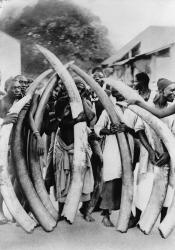Ivory Trade
Ivory trade refers to the illegal buying and selling of ivory tusks, commonly from elephants. Internationally, commercial ivory trade was not banned until 1989, but illegal elephant poaching continued into the 21st century (Fighting to End the Elephant Ivory Trade).
While the trade of ivory can be traced back to ancient times, it developed greatly during the nineteenth century, especially in eastern and central Africa. A high demand from Europe and North America increased the export value of the resource (Beachey 269). Ivory was used in various ways, from piano keys to jewelry, and was an extravagant display of wealth. The value of ivory also stayed fairly consistent throughout the nineteenth century, helping it to maintain its demand.
Being that ivory quickly became an important economic export, it makes sense that European nations in the midst of industrial and economic revolutions would take an opportunity to become involved. Countries like Belgium colonized African countries and took advantage of the native people to grow their economies, a system that Joseph Conrad criticizes in his novella Herat of Darkness.
Works Cited
Beachey, R. W. "The East African Ivory Trade in the Nineteenth Century." The Journal of African History, vol. 8, no. 2, 1967, pp. 269-90. JSTOR, www.jstor.org/stable/179483. Accessed 4 Apr. 2023.
Conrad, Joseph. Heart of Darkness. 1899.
"Fighting to End the Elephant Ivory Trade." World Wide Fund for Nature, www.wwf.org.uk/updates/fighting-end-elephant-ivory-trade. Accessed 4 Apr. 2023.

